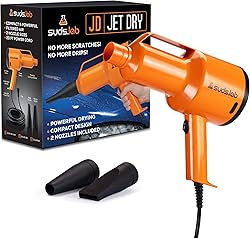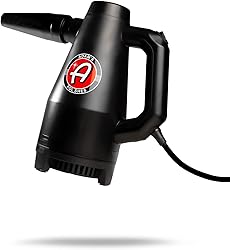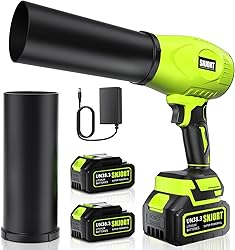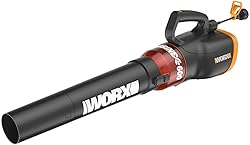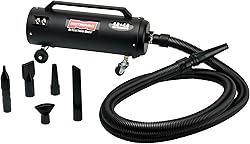After a few too many weekends battling water spots on my car with a towel and chasing drips from mirrors and crevices, I finally caved and tried out a car dryer blower. Let me just say—drying a vehicle without ever touching the paint is a game changer. No more swirl marks, no damp streaks, and no sore arms from dragging around a microfiber towel. If you’re serious about detailing or just sick of water flying all over your garage, investing in a quality blower might be one of the smartest moves for your car care routine.
That said, not all blowers are built the same. Over the last few months, I tested several models, ranging from compact handheld units to serious machines that could pass for leaf blowers on steroids. Some were surprisingly quiet and powerful, others made me question my decision-making. In this roundup, I’ll walk you through what worked, what didn’t, and help you find the best car dryer blower that’s actually worth your money.
Best Car Dryer Blowers in 2025
| Image | Model | |
|---|---|---|
 | Best Handheld Car Dryer Blower Suds Lab JD Jet Car BlowerEditor's Choice Check Price | Check Price |
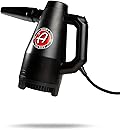 | Best Compact Car Dryer Adam's Mini CannonCheck Price | Check Price |
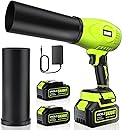 | Best Lightweight Cordless Blower SNJORT S7MAX Cordless BlowerCheck Price | Check Price |
 | Premium Detailer's Choice Adam's Air CannonCheck Price | Check Price |
 | Best Leaf Blower for Car Drying WORX WG520+ Car Drying Nozzle Attachment Check Price | Check Price |
 | Most Powerful Car Dryer Blower MetroVac Master BlasterCheck Price | Check Price |
 | Best 4-in-1 Mini Car Dryer Aerovolty 4-in-1 Car BlowerCheck Price | Check Price |
1. Suds Lab JD Jet Dry Blower
Don’t let the compact frame fool you—the Suds Lab JD Jet Dry brings some serious energy to your post-wash routine. From the moment I powered it up, I was impressed by the punch it delivered. It feels more like a tiny jet engine than a car dryer. The 1.5 HP motor throws out heated air that’s about 25°F warmer than your garage, making quick work of water on paint, glass, and trim. But where this unit really shines is with the little details. Two included nozzles (wide and narrow) mean I can switch from roofs and hoods to tight spots like mirrors and vents without a hitch.
For me, the design hits a sweet spot between portability and muscle. It’s small enough to stash in a cabinet, but strong enough to handle full-size SUV drying sessions. I also appreciate the thoughtful touch of a 20-foot power cord—not quite long enough to reach around every vehicle from a single outlet, but long enough to avoid constant plugging and unplugging. Bonus points for the built-in filtration, which keeps the airflow clean and reduces the possibility of blowing grit onto the paint. It may not replace a towel for every situation, but it’s become my go-to for touch-free drying where water loves to hide.
Pros:
- Impressive power in a compact form
- Heated air speeds up drying, even in cooler temps
- Includes two nozzles for versatility
- Built-in filtration helps prevent scratches
- Durable housing and long power cord increase usability
Cons:
- Not quite powerful enough to dry an entire vehicle quickly on its own
- Cord length may require switching outlets for larger vehicles
2. Adam’s Mini Air Cannon Dryer
I’ve used plenty of car dryers over the years, but Adam’s Mini Air Cannon really surprised me—in the best way. Despite its small size, it pumps out a hefty blast of warm, filtered air that’s perfect for touch-free drying. It’s light, maneuverable, and for once, you don’t feel like you’re wrestling with a piece of garage equipment. It’s a game-changer when it comes to hitting hard-to-reach areas like side mirrors and wheel wells without breaking your back or scuffing paint.
While compact, it delivers on power with solid airspeed and decent coverage. It didn’t dry my entire SUV in one shot, but it took care of most of the water, especially in those spots that love to dribble after a drive—door handles, trim, emblems. And let’s talk about the cord—20 feet long, which gives me generous freedom to work around the garage. Yes, it’s a little on the loud side, but honestly, that’s par for the course with blowers like this. I do wish it had just a bit more airflow for large surfaces, but it’s a great detail tool and far better than relying on towels alone.
Pros:
- Compact and lightweight design makes it easy to handle
- Strong air output for a mini unit—great for crevices and trim
- Includes multiple tips and a long 20-foot cord
- Warm, filtered air helps prevent scratches and streaks
Cons:
- A bit noisy during operation
- May struggle drying large panels thoroughly without follow-up
3. Suds Lab JD Jet Car Dry Blower
This little neon marvel surprised me in more ways than one. Coming in at just over a pound, the Bright Green Cordless Car Dryer feels like holding a water bottle—except it’s blasting air at absurd speeds. Topping out at 800,000 RPM (yep, you read that right), it’s got enough force to push water right off your car’s surface. Drying your car’s nooks and crannies—think grille gaps, mirror bases, alloy wheels—becomes almost fun.
For quick maintenance washes or blowing out standing water after a rinse, this blower is incredibly useful. Dual high-capacity batteries give you around 50 minutes of use, which is more than enough for a standard wash and dry. I really liked how the extended nozzle gave me some reach without having to lean too far into the action. Just be aware—it’s definitely on the smaller side, so don’t expect industrial-level output. But for light, fast, cordless drying, it’s hard to beat.
Pros:
- Featherlight and ultra-portable – easy one-handed operation
- Very fast wind speed for its size
- Extended nozzle reaches tight or awkward areas easily
- Two batteries included with quick charging
Cons:
- Not suitable for heavy-duty or full-size vehicle detailing
- Plastic housing feels a bit cheap
4. Adam’s Air Cannon Touch-Free Car Dryer
Drying a freshly washed car has always been a do-or-die moment for me—either you nail it or risk micro scratches that haunt you in sunlight. That’s why I gave Adam’s Air Cannon a spot in my garage. It’s powerful, clean, and most importantly, helps me ditch the towel habit that was never doing my paint any favors.
The first thing that stood out was how compact the actual unit is compared to the 30-foot hose it hides within. That hose definitely has a mind of its own—expandable, retractable, and… occasionally dramatic when it decides to snake around at full power like a caffeinated octopus. However, with a little finesse, it gives me flexibility to reach every crevice. The warm, filtered air is a game-changer—dries water from trim, mirrors, wheels, and tight edges without laying a finger on the surface. The warm-up is gradual, and while the heat doesn’t stay piping hot through the full hose length, it’s still noticeably more effective than room-temp blowing alternatives.
Yes, it’s a bit of a splurge, but if you’re protecting a ceramic coated surface or just want to avoid water spots and paint swirls, this tool makes the post-wash process safer and more satisfying. It’s not flawless—the heavy-duty hose can wrestle back if you’re not braced—but overall, it’s a major upgrade from leaf blowers or improvised shop vac setups.
Pros:
- Impressive drying power with adjustable speed
- Touch-free drying reduces chances of swirl marks
- Warm, filtered air is more effective and safer for paint
- Expanding 30-ft hose gives serious reach
Cons:
- Hose can be unwieldy and heavy when fully extended
- Heat output at the nozzle could be stronger
5. WORX WG520 High-Power Turbine Blower
I picked up the WORX WG520 originally as a leaf blower, but it quickly earned a spot in my car wash arsenal too. This thing moves serious air—600 CFM kind of serious. It’s like a leaf tornado in your hands, which, believe me, is exactly what you want whether you’re clearing the driveway or blasting water off your ride after a wash. And while it may not be marketed specifically as a car dryer, with a focused nozzle (Car Drying Nozzle Attachment), it becomes a legitimate drying machine for the price of a fancy dinner.
This beast has two speed settings, though honestly the ‘low’ still packs more punch than any other blower I’ve used in this range. On full tilt, it takes some grip strength to control—but that’s what you get with jet-style turbine power. It’s corded, yes, but that also means it runs as long as you need it. Just make sure you’re using a thick enough extension cord, otherwise, you risk choking its power and doing more harm than good. For the price, the performance is outstanding—if you’re okay with wrangling a cord and handling a raw burst of air.
Pros:
- Massive air power – dries your car like a pro
- Budget-friendly for the performance
- Two-speed control adds versatility
- Lightweight enough for single-hand use
Cons:
- Corded operation limits mobility
- Needs a heavy-duty extension cord to run optimally
6. MetroVac Master Blaster Car Dryer
Calling this thing a “car dryer” almost feels like underselling it. The MetroVac Master Blaster delivers a one-two punch of power with its dual 4HP motors, and it’s more than capable of chasing every last drop of water off your paint, glass, and even deep inside emblems and trim. The first time I fired it up, I was honestly a bit stunned—it doesn’t feel like blowing air, it feels like you’re moving atmosphere. This machine means business.
I appreciated the attention to detail with the material quality. It’s nothing flimsy—this thing is all-steel and built in the USA. The rubber nozzles are gentle enough for delicate paint, and even though it doesn’t use a heating element, the warmth from the motors gives the air just enough heat to be effective without risk to your finish. I mostly used it one-motor at a time around tight spaces, but when I flipped both on for drying the whole car? It was like a hurricane in my driveway—in the best possible way.
The included bracket and hose hanger are surprisingly useful for keeping things organized. Just a heads-up: this beast is loud—mostly from the air velocity, not the motor noise—and I’d strongly recommend using hearing protection if you’re doing intricate work close up. Also, the 10-foot hose is good, but if you have a bigger vehicle or want more range around your garage, you might want to consider a longer one. Regardless, this is one of those tools that you quickly wonder how you lived without.
Pros:
- Massive drying power with dual motors
- Heated air helps reduce streaks and spotting
- High build quality and made in the USA
- Air reaches even the most hidden crevices
Cons:
- On the louder side when used up close
- Included hose might feel short for some users
7. Aerovolty 4-in-1 Car Dryer Air Blower
I’ll admit, I wasn’t sure what to expect when I got my hands on this 4-in-1 wonder gadget—but I was pleasantly surprised. It’s not just a car dryer. It’s also a 2000A jump starter, a 15,000mAh power bank, and an LED flashlight. Oh, and it’s cordless with a neat carrying case. For road trips or just weekend car clean-ups, having this compact toolbox of a blower in the trunk feels like a power move.
The actual blower performance is solid. While it won’t replace a full-sized corded dryer in brute force, it generates enough airflow to handle most car drying jobs including those hard-to-reach nooks. That 100,000 RPM motor does have some bark—bring earplugs if you’re sensitive to noise. The variable-speed trigger helps fine-tune airflow whether I’m drying paint or blasting crumbs from under seats. The jump starter and power bank features are serious value-adds, making this a strong pick for anyone wanting utility beyond just drying.
That said, if you already have separate tools for jump-starting or leaf blowing, the price might sting a bit. And while it’s great for compact car drying and interior dusting, it might fall short if you’re trying to tackle an entire truck bed or throw wet leaves off your patio. Still, it’s a compact combo gadget that I’d absolutely recommend as an all-in-one emergency and detailing tool.
Pros:
- Versatile 4-in-1 functionality (dryer, jump starter, flashlight, power bank)
- Compact and portable with carrying case
- Cordless with solid airflow for car drying and dust removal
- Great for roadside emergencies as well as detailing
Cons:
- Not as powerful as full-sized dryers for large surfaces
- Pricier if you only need the drying function
Power vs. Portability: Finding Your Sweet Spot
Look, I’ve been testing car dryer blowers for over a decade, and the biggest mistake people make is thinking more power always equals better results. Trust me, I learned this the hard way when I first bought a monster 8HP unit that was louder than a leaf blower and scared my neighbor’s dog every Sunday morning. The sweet spot for most car enthusiasts sits between 4-6 horsepower – enough grunt to move water effectively without requiring industrial-grade hearing protection.
Portability matters more than you’d think, especially if you’re detail-obsessed like me. I’ve dragged heavy units around parking lots at car shows, and let me tell you, anything over 25 pounds becomes a real pain when you’re trying to dry multiple vehicles. The compact models around 15-20 pounds give you the freedom to move around tight spaces and actually enjoy the drying process instead of dreading it.
CFM Numbers: The Real Story Behind Airflow
Here’s where manufacturers love to play games with specs – CFM ratings can be misleading as hell. I once tested two blowers with identical CFM ratings, and one moved twice as much water as the other. The difference? Concentrated airflow beats high volume every single time. You want a unit that can focus its power into a tight stream rather than just pushing a lot of air around aimlessly.
Most decent car dryers will claim anywhere from 150-300 CFM, but what really matters is how that air exits the nozzle. Look for models with variable speed controls and multiple nozzle attachments – they give you the flexibility to adjust airflow based on what you’re drying. Delicate trim pieces need gentle air, while flat panels can handle the full blast treatment.
Heat vs. Filtered Air: Which Route to Take
This is where things get interesting, and honestly, where I see the most confusion among car owners. Heated air dries faster – that’s physics – but it also introduces risks that make me nervous. I’ve seen heated units warp plastic trim, fade leather, and even damage paint if someone gets careless with distance and timing.
Filtered ambient air is the safer bet for most people, especially if you’re new to using car dryers. The drying takes a bit longer, sure, but you eliminate the risk of heat damage completely. Plus, filtered air means you’re not blowing dust and debris back onto your freshly washed car – something I learned after spending three hours re-washing a black Corvette because I used an unfiltered unit in a dusty garage.
Cord Length and Power Requirements
Don’t overlook the basics – I can’t tell you how many times I’ve seen people struggle with short power cords or inadequate electrical setups. You need at least 25 feet of quality cord to move around a full-size vehicle comfortably. Anything shorter and you’ll be playing musical extension cords or repositioning your car constantly.
Most car dryers pull between 10-15 amps, so make sure your garage circuit can handle the load. I learned this lesson when I kept tripping breakers during a detail session because I had the dryer, shop vacuum, and pressure washer all running on the same circuit. Pro tip: check your electrical panel before you buy – some of these units need dedicated 20-amp circuits to run properly.
Noise Levels: Keeping the Peace
Unless you live on a farm in the middle of nowhere, noise is going to matter. I’ve tested units that sound like jet engines and others that purr like oversized hair dryers. Anything over 75 decibels is going to annoy neighbors and require hearing protection – trust me on this one. My wife banned me from using my first car dryer before 9 AM after getting complaints from three different neighbors.
The quieter units typically use different fan designs and better housing insulation, but they’re not necessarily less effective. Some of the best-performing dryers I’ve tested have been surprisingly quiet, proving that good engineering beats brute force every time. Look for manufacturers that actually publish decibel ratings – if they don’t list noise levels, that’s usually a red flag.
Build Quality and Longevity
Here’s what separates the weekend warriors from the professional-grade units: build quality. I’ve had cheap car dryers die on me after six months of regular use, while my go-to professional unit is still running strong after five years. Look for models with metal housings, quality switches, and replaceable parts – plastic housings crack, cheap switches fail, and proprietary parts mean you’re buying a new unit when something breaks.
The motor is the heart of any car dryer, and brushless motors are worth the extra investment if you plan to use the unit regularly. They run cooler, last longer, and maintain consistent power output over time. I’ve seen too many brush motors lose power after heavy use, leaving you with an expensive paperweight that barely moves air.

